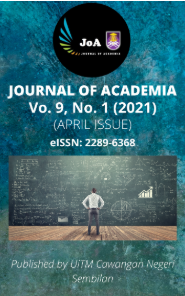COLOURFASTNESS PROPERTIES OF NATURAL DYE FROM TAGETES ERECTA ON SILK FABRIC USING DIFFERENT DYEING TECHNIQUES
Keywords:
infrared dyeing, natural dye, natural mordant, silk, tagetes erectaAbstract
Of late, dyeing fabrics with natural dyes have become an attraction because of its eco-friendly and less threatening disposition towards humankind. In the textile colouration industry, natural dyes play an important role because of the need for replacement synthetic dyes which have a great deal of tension with the environmental issues. This study focuses on the colour shade, colour coordinates, and fastness properties of dyed silk fabric from tagetes erecta (Mexican Marigold flower) using the water boiling extraction method. The dyeing was carried out using lemon juice as a natural mordant through the simultaneous mordanting method, using two different dyeing methods: infrared (IR) dyeing and exhaustion dyeing. The shades produced for exhaustion dyed fabric is light-yellow compared to the IR dyed fabric, which is medium-light yellow. These shades were confirmed with the CIELAB colour coordinates, L*a*b* values. The colourfastness to washing, perspiration, rubbing, and light of the fabrics were conducted to investigate the performance of the dye and mordant on the dyed silk fabrics. The colourfastness properties of the dyed silk fabric using infrared (IR) dyeing technique have better performance than using exhaustion dyeing technique.
References
Arora, J., Agarwal, P., & Gupta, G. (2017). Rainbow of Natural Dyes on Textiles Using Plants Extracts: Sustainable and Eco-Friendly Processes. Green and Sustainable Chemistry, 07(01), 35–47. https://doi.org/10.4236/gsc.2017.71003
Bahlool, S.O. (2019). Dyeing Of Cotton Fabric with Reactive Dye Using Infrared Heating Technique. Egyptian Journal of Agricultural Research, 97(1), 407–417. https://doi.org/10.21608/ejar.2019.68703
Bechtold, T., Mahmud-Ali, A., & Mussak, R. A. M. (2007). Reuse of ash-tree (Fraxinus excelsior L.) bark as natural dyes for textile dyeing: process conditions and process stability. Coloration Technology, 123(4), 271–279. https://doi.org/10.1111/j.1478-4408.2007.00095.x
Gupta, D., Agrawal, A., Chaudhary, H., Gulrajani, M., & Gupta, C. (2013). Cleaner process for extraction of sericin using infrared. Journal of Cleaner Production, 52, 488–494. https://doi.org/10.1016/j.jclepro.2013.03.016
Jothi, D. (2008). Extraction of natural dyes from African marigold flower (Tagetes erecta L.) for textile coloration. Autex Research Journal, 8(2), 49-53.
Kale, R. D., Maurya, Y., Dash, S., & Potdar, T. (2018). Improvement in the light fastness of dyed meta-aramid fabric using titanium dioxide nanoparticles. Coloration Technology, 134(6), 464–469. https://doi.org/10.1111/cote.12363
Kim, Y., & Choi, J. (2015). Dyeing properties of microbial prodiginine from Zooshikella rubidus for silk fabrics. Fibers and Polymers, 16(9), 1981–1987. https://doi.org/10.1007/s12221-015-5211-3
Lee, J., Kang, M., Lee, K. B., & Lee, Y. (2013). Characterization of Natural Dyes and Traditional Korean Silk Fabric by Surface Analytical Techniques. Materials, 6(5), 2007–2025. https://doi.org/10.3390/ma6052007
Paul, D., Das, S. C., Islam, T., Siddiqueee, M.A.B., & Al, M. A. (2017). Effect of Alkali Concentration on Dyeing Cotton Knitted Fabrics with Reactive Dyes. Journal of Chemistry and Chemical Engineering, 11(4), 388–399. https://doi.org/10.17265/1934-7375/2017.04.004
Satpathy, R., Behera, R., & Padhi, C. (2019). Dyeplantdb: A database of dye yielding plants. Agrica, 8(1), 37. https://doi.org/10.5958/2394-448x.2019.00006.3
Saxena, S., & Raja, A. S. M. (2014). Natural Dyes: Sources, Chemistry, Application and Sustainability Issues. Textile Science and Clothing Technology, 37–80. https://doi.org/10.1007/978-981-287-065-0_2
Shabbir, M., Bukhari, M. N., Khan, M. A., & Mohammad, F. (2018). Extraction of Carotenoid Colorants from Tagetes erecta (Marigold) Flowers and Application on Textile Substrate for Coloration. Current Smart Materials, 3(2), 124–135. https://doi.org/10.2174/2405465803666180601095741
Shahid, M., & Mohammad, F. (2013). Recent advancements in natural dye applications: a review. Journal of Cleaner Production, 53, 310–331. https://doi.org/10.1016/j.jclepro.2013.03.031
Vankar, P. (2017). Description of the newer natural dye sources suitable for wool yarn. Natural Dyes for Textiles, 29-32. https://doi.org/10.1016/b978-0-08-101274-1.00008-2
Vignesh, V., Chakrabarti, S., & Srivastava, S. (2014). An experimental study on the load modelling using PMU measurements. 2014 IEEE PES T&D Conference and Exposition, 1–5. https://doi.org/10.1109/tdc.2014.6863487
Yusuf, M., Shahid, M., Khan, M. I., Khan, S. A., Khan, M. A., & Mohammad, F. (2015). Dyeing studies with henna and madder: A research on effect of tin (II) chloride mordant. Journal of Saudi Chemical Society, 19(1), 64–72. https://doi.org/10.1016/j.jscs.2011.12.020
Downloads
Published
Issue
Section
License
Copyright (c) 2021 Journal of Academia

This work is licensed under a Creative Commons Attribution-NonCommercial-NoDerivatives 4.0 International License.












